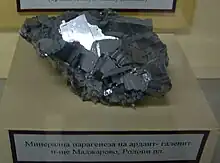| Ardaite | |
|---|---|
 Ardaite associated with galena, Madjarovo polymetallic ore deposit, National Museum of Natural History, Bulgaria | |
| General | |
| Category | Sulfosalt minerals, Lead minerals |
| Formula (repeating unit) | Pb19Sb13S35Cl7 |
| IMA symbol | Ada[1] |
| Strunz classification | 2.LB.30 (10 ed) 2/E.19-20 (8 ed) |
| Dana classification | 02.15.01.01 |
| Crystal system | Monoclinic Unknown space group |
| Identification | |
| Color | Greenish gray or bluish green |
| Mohs scale hardness | 2.5-3 |
| Luster | Metallic |
| Density | 6.44 |
| Pleochroism | Weak |
| References | Breskovska, V. V.; Mozgova, N. N.; Bortnikov, N. S.; Gorshkov, A. I.; Tzepin, A. I. (1982), "Ardaite, a new lead-antimony chlorsulphosalt" (PDF), Mineral. Mag., 46 (340): 357–361, Bibcode:1982MinM...46..357B, doi:10.1180/minmag.1982.046.340.10, S2CID 128756669 |
Ardaite is a very rare sulfosalt mineral with chemical formula Pb19Sb13S35Cl7 in the monoclinic crystal system,[2][3] named after the Arda River, which passes through the type locality.[4] It was discovered in 1978 and approved by the International Mineralogical Association in 1980.[5][6][7] It was the second well-defined natural chlorosulfosalt, after dadsonite.[8]

Greenish gray or bluish green in color, its luster is metallic. Ardaite occurs as 50 µm fine-grained aggregates of acicular crystals associated with galena, pyrostilpnite, anglesite, nadorite, and chlorine-bearing robinsonite and semseyite, in the Madjarovo polymetallic ore deposit in Bulgaria. Ardaite has a hardness of 2.5 to 3 on Mohs scale and a density of approximately 6.44.[2]
The type locality is the Madjarovo polymetallic ore deposit in the Rhodope Mountains.[9][10] Later its occurrence was proved in the Gruvåsen deposit, near Filipstad, Bergslagen, Sweden.[6]
See also
List of minerals recognized by the International Mineralogical Association
References
- ↑ Warr, L.N. (2021). "IMA–CNMNC approved mineral symbols". Mineralogical Magazine. 85 (3): 291–320. Bibcode:2021MinM...85..291W. doi:10.1180/mgm.2021.43. S2CID 235729616.
- 1 2 "Information page for Ardaite". mindat.org.
- ↑ "Information page for Ardaite". webmineral.com.
- ↑ "Information page for Ardaite" (PDF). Handbook of Mineralogy.
- ↑ Breskovska, V. V.; Mozgova, N. N.; Bortnikov, N. S.; Gorshkov, A. I.; Tzepin, A. I. (1982), "Ardaite, a new lead-antimony chlorsulphosalt" (PDF), Mineral. Mag., 46 (340): 357–361, Bibcode:1982MinM...46..357B, doi:10.1180/minmag.1982.046.340.10, S2CID 128756669
- 1 2 Burke, E.A.J.; Kieft, C.; Zakrzewski, M.A. (1981), "The Second Occurrence of Ardaite" (PDF), Canadian Mineralogist, 19: 419–422, retrieved 3 May 2018
- ↑ Dunn, Pete; Fleischer, Michael (1983), "New Mineral Names" (PDF), American Mineralogist, 68: 643
- ↑ Zelenski, Michael; Zunic, Tonci Balic; Bindi, Luca; Caravelli, Anna; Makovicky, Emil; Pinto, Daniela; Vurro, Filippo (2006), "First Occurrence of Iodine in Natural Sulfosalts: The Case of Mutnovscite" (PDF), American Mineralogist, 91: 21–28, doi:10.2138/am.2006.1870, S2CID 55370927
- ↑ "Collection of Minerals". National Natural History Museum, Sofia, Bulgaria.
- ↑ "Madjarovo deposit". mindat.com.
External links
- Gaines, Richard V.; Skinner, H. Catherine W.; Foord, Eugene E.; Mason, Brian; Rosenzweig, Abraham; King, Vendall (1997). Dana's New Mineralogy: The System of Mineralogy of James Dwight Dana and Edward Salisbury Dana. New York, Chichester, Weinheim, Brisbane, Singapore, Toronto: John Wiley & Sons, Inc. p. 142. ISBN 9780471193104.